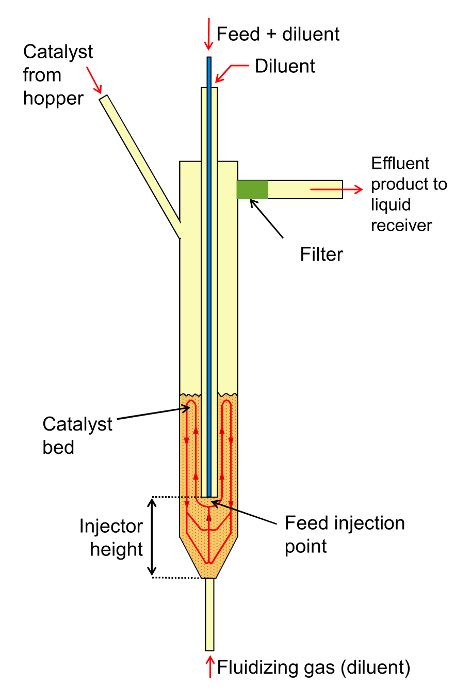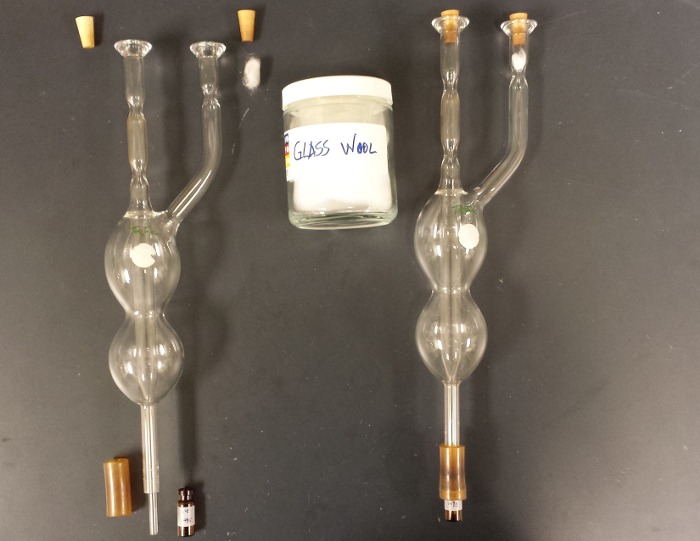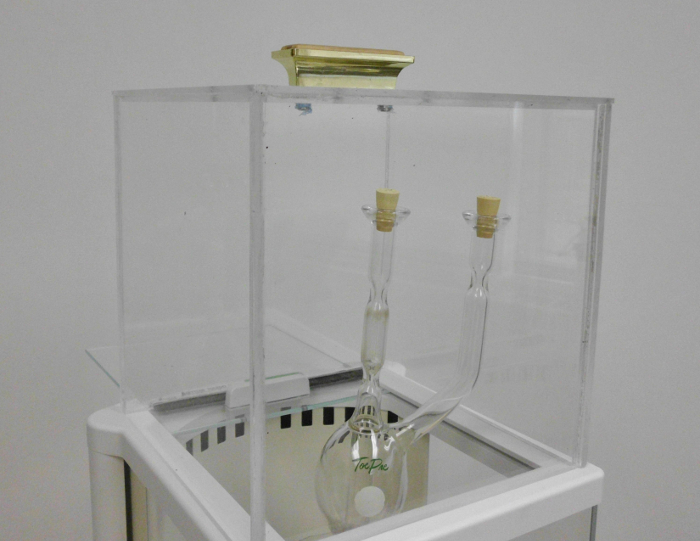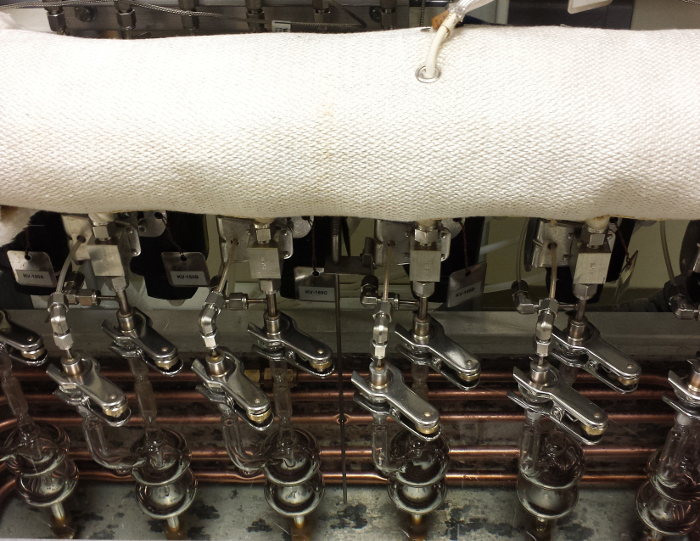このコンテンツを視聴するには、JoVE 購読が必要です。 サインイン又は無料トライアルを申し込む。
Method Article
接触分解変換により菜種油からバイオ燃料および生化学の研究室の生産
要約
本稿では、穏やかな温度で触媒の存在下で化石ベースのフィードと混合したキャノーラ油からのバイオ燃料とバイオケミカルを製造するための実験的な方法を提示します。反応器からの気体、液体、および固体の生成物を定量し、特徴付けられます。変換および個々の製品の収率が計算され、報告されています。
要約
The work is based on a reported study which investigates the processability of canola oil (bio-feed) in the presence of bitumen-derived heavy gas oil (HGO) for production of transportation fuels through a fluid catalytic cracking (FCC) route. Cracking experiments are performed with a fully automated reaction unit at a fixed weight hourly space velocity (WHSV) of 8 hr-1, 490-530 °C, and catalyst/oil ratios of 4-12 g/g. When a feed is in contact with catalyst in the fluid-bed reactor, cracking takes place generating gaseous, liquid, and solid products. The vapor produced is condensed and collected in a liquid receiver at -15 °C. The non-condensable effluent is first directed to a vessel and is sent, after homogenization, to an on-line gas chromatograph (GC) for refinery gas analysis. The coke deposited on the catalyst is determined in situ by burning the spent catalyst in air at high temperatures. Levels of CO2 are measured quantitatively via an infrared (IR) cell, and are converted to coke yield. Liquid samples in the receivers are analyzed by GC for simulated distillation to determine the amounts in different boiling ranges, i.e., IBP-221 °C (gasoline), 221-343 °C (light cycle oil), and 343 °C+ (heavy cycle oil). Cracking of a feed containing canola oil generates water, which appears at the bottom of a liquid receiver and on its inner wall. Recovery of water on the wall is achieved through washing with methanol followed by Karl Fischer titration for water content. Basic results reported include conversion (the portion of the feed converted to gas and liquid product with a boiling point below 221 °C, coke, and water, if present) and yields of dry gas (H2-C2's, CO, and CO2), liquefied petroleum gas (C3-C4), gasoline, light cycle oil, heavy cycle oil, coke, and water, if present.
概要
バイオマス由来の原料から輸送燃料を製造するための効率的かつ経済的な手段を見つけるために、民間部門と公共部門の両方で強力なグローバル関心があります。この関心は温室効果ガス(GHG)の排出と地球温暖化への関連寄与石油化石燃料の燃焼の実質的な貢献を超える一般的な懸念によって駆動されます。また、再生可能な国内の液体燃料と外国産石油を置換する北米やヨーロッパで強い政治的意志があります。 2008年には、バイオ燃料が世界の輸送燃料1の1.8%を提供しました。多くの先進国では、バイオ燃料が近い将来2に石油燃料の10%6%から置換することが必要です。カナダでは、規制が3。欧州における再生可能エネルギー指令(RED)は、欧州連合(EU)トランスのための10%の再生可能エネルギー目標を義務付けた2010年12月15日出発ガソリン中の5%の平均再生可能燃料のコンテンツを必要とします2020年4による港湾セクター。
課題は、バイオマスから代替可能な輸送燃料を製造するための実行可能な経済的な経路を開発し、実証することでした。生物学的供給源は、木材チップ、森林廃棄物、農業残渣などのトリグリセリドベースのような植物油や動物性脂肪などのバイオマスだけでなく、廃食用油とセルロース系バイオマスを含みます。過去20年間にわたり、研究を用いて、バイオマス由来の油処理の評価に焦点を当ててきた従来の(FCC)5流動接触分解- 12、石油精製所でガソリンのほとんどを生産する責任技術を。本研究で我々の新しいアプローチは、オイルサンドビチューメン由来の原料と混合する同時プロセスのキャノーラ油です。通常、ビチューメンは、合成原油(SCO)はGHG emissiの68から78パーセントを占め、処理ルートは、特にエネルギー集約的である - これとして精油所原料を生産、前精錬にアップグレードする必要がありますカナダの総温室効果ガス排出量14の2.6%を構成し、SCOの生産13と、2011年からアドオン。バイオ燃料の生産がはるかに小さいカーボンフットプリントを含むのでbiofeedでアップグレードHGOの一部を置き換えることは、温室効果ガスの排出量を減少させるであろう。それはカナダと米国で豊富であるため、キャノーラ油は、この作品に選ばれています。この原料は、FCC性能や製品の品質に影響を与える可能性が硫黄、窒素、および金属の内容は無視され、一方HGOsと同様の密度および粘度を有しています。また、この共同処理オプションは、それは少し追加のハードウェアや製油所の修正を必要とするであろう、したがって、既存の製油所のインフラストラクチャの利用を可能にし、同じよう重要な技術的および経済的な利点を提供しています。加えて、共処理高い芳香ビチューメンが直鎖状バイオマス対応して供給するとき、製品の品質向上につながる可能性が潜在的な相乗効果が存在してもよいです。しかし、同時処理重要な技術的課題を伴います。高酸素含有量、パラフィンリッチな組成、石油供給原料との相溶性、汚染電位、 等 :これらは、バイオフィードのユニークな物理的及び化学的特性を含みます
本研究では、接触分解を通じてキャノーラ油から実験室規模でのバイオ燃料の生産のための詳細なプロトコルを提供します。完全に自動化された反応系-臨床検査ユニット(LTU)15としてこの仕事に呼ば-この仕事のために使用されている。図1は、本機の動作を模式的方法を示しています。このLTUは、実験室FCC研究のための業界標準となっています。本研究の目的は、温室効果ガス排出量を軽減することを目標に燃料や化学物質を生成するためにキャノーラ油をクラッキングするためのLTUの適合性をテストすることです。

図1:概念illustratio原子炉。触媒の流線を示すイラスト、飼料、製品、および希釈剤のn個。 この図の拡大版をご覧になるにはこちらをクリックしてください。
プロトコル
注意:材料を使用する前に、関連するすべての物質安全データシート(MSDS)を参照してください。通気換気フード内で起こらなければならない適切な個人用保護具(安全眼鏡、手袋、ズボン、クローズドつま先の靴、白衣)、および開口部、転送し、粗サンプルの取り扱いを身に着けている間、原油サンプルと協力してのみ行われるべきです。加熱された炭化水素は空気中の可燃性とすることができ、反応系には、慎重に原油の混合物で使用する前に漏れ、チェックする必要があります。反応器を750℃程度の高温に達することができ、加熱した表面付近で作業する場合、高温安全手袋を使用する必要があります。
1.一般的な考慮事項
- 〜8時間かけて6回連続ランを完了することができ、自動化反応部、を最大限に活用するために、1.2グラム/分の一定の供給速度を選択します。これは関係WHSV = 60 / [(C / O)×T] = 60×(O /トン)を介して、8時間-1に重量空間速度(WHSV)を設定/ C FEはトンをここでエド配信分の時間とCとOグラムで、それぞれ、触媒および飼料の塊です。供給噴射時間を変更することによって、4、6、8、10、及び11.25(×2)の触媒/油の質量比のセットは、変換の広い範囲を達成するために、各反応温度のために達成されました。
2.原料と触媒調製
- 合成原油(SCO)の(バンドをスピニング)-343℃の留分を蒸留することによりHGOを取得します。
- 地元の食料品店から食用グレードのキャノーラ油を購入し、さらに処理することなく使用しています。
- 13.7535グラムキャノーラ油(0.9169グラム/ mlの濃度)でHGO(0.9370グラム/ミリリットルの密度)の79.645グラムを混合することにより、15体積%のキャノーラブレンドを準備します。
- 400タイラーメッシュ篩(38μmの開口部)との二次スクリーニングに続いて60タイラーメッシュ篩(250μmの開口部)を、使用した平衡触媒を画面。
- その後、4時間600℃で、オンサイズ粒子(38から250μm)を焼成トンにロード彼自動化された反応部の6ホッパー。
3.試験手順
- システムの準備
- プログラムの準備
- 反応器を制御するソフトウェアを使用して、運転条件のためのウィンドウを開きます。
- 実行期間の各工程における原料及び触媒、気圧、噴射時間、及び供給システム、原子炉、製品ライン、冷却水用の温度設定点、およびCO触媒コンバータの識別を入力。
- 触媒調製
- プロセスチューブ上記各触媒ガラスホッパーは、ホッパーに焼成上のサイズ触媒の蓋と電荷9グラムを削除します。ホッパーの頂部にOリングを取り付け、その蓋を再クランプ。
- 送り速度の校正
- すべてのクラッキングの実行のための一定の供給注入速度(1.2グラム/分)でフィードを配信するために、オイル供給ポンプを設定します。
- 大井を外しパージ弁(KV-114)16以下リットル供給ラインと風袋を計ったビーカーに油の配信のためにバルブの底に短い一時的なチューブを取り付けます。
- で、シリンジから出て、供給ラインに沿って容易に流れるようにHGO-ブレンドを可能にするために85°Cに原料を予熱。
- シリーズ(デフォルト設定)での最初の実行の場合と同じ値にポンプを較正するための噴射時間を設定します。
- ビーカーを風袋引きし、短い一時的なチューブの放電時にそれを置きます。反応部ソフトウェアのプリセット「PUMPCAL「ユーザプログラム17を起動します。
- PUMPCALプログラムが完了したら、フィードを含むビーカーを除去し、秤量します。飼料の質量供給速度を得るために、噴射時間によりビーカーに送達分けます。
- (ポンプに3桁のダイヤルを使用して)より高いまたはより低いにポンプ速度を調整し、所望の送り速度が達成されるまで3.1.3.6に、手順3.1.3.5を繰り返します。
- 削除します短い一時的なチューブ及び供給ラインを再接続します。
- ガス分析のためのGCのキャリブレーション
注意:ガス分析のためのGCを基準チェック、データの傾向、及び物質収支から推測することができるキャリブレーションのうちであることがわかっている場合、このステップは必要です。経験は、GCのキャリブレーションが長期間に頼ることができることを示しています。- 手動バルブ(HV-190)16に商用多成分製油所ガス標準のシリンダーを接続します。
- 溶出および製油所ガス標準ですべてのピークを分離することができるGCソフトウェアの方法をロードします。 表1にGCメソッドのパラメータを使用してください。
- GCソフトウェアを使用して、製油所ガス、標準の分析の実行を行います。
- 製油所ガス標準のクロマトグラムを開き、クロマトグラムのピークを統合します。
- CALIBのコンポーネントのすべてを確認して、クロマトグラムのピークを同定配給ガスが発見されました。存在するが、標準のコンポーネントに起因することはできません任意のピークを削除します。
- C 6 + 1、C 6 + 2、+ 3 C 6、およびC 6 + 4群にC 5後に溶出する保持時間の範囲、塊除算化合物に基づきます。この方法では、しこりメチルペンテンは、一つのCに5オレフィン基を異性体。
- GCソフトウェアを使用して、キャリブレーション機能の下で、ガスの標準から各集積ピークに濃度値を割り当てます。
- その後のテスト実行中にピークの濃度を決定するために使用するために、メソッドファイルへのキャリブレーションを保存します。商業用ガス標準を外します。
- CO 2アナライザの校正
- 反応ユニットのソフトウェアを介して、赤外線ガス分析装置に流れるように、ゼロガス(窒素)を有効の位置にバルブ(KV-170)16を切り替えます。フロー制御のvalに関連して、ノブを回して流れを調整(FCV-107)16、必要に応じて、フローインジケータ(FI-107)で約250 SCCMを取得する16 VEの 。
- ゼロマイナスドライバーの助けを借りて、分析装置のフロントパネルのゼロ調整ねじを使用して分析装置。
- アナライザにCO 2(19.8モル%)の標準ガスを供給するための手動弁(HV-107)16を切り替えます。フローインジケータ(FI-107)で約250 SCCMの流れを得るために、マニュアルバルブ(MV-107)16を調整します。
- フロントパネル上のSPANのネジを使用して、標準的なスパンガスの濃度(19.8モル%)を一致させるために読んアナライザを調整します。
- スパンガスを外し、RUNの位置に手動バルブ(HV-107)を返します。
- 液体製品レシーバの調製
注:各レシーバは、シリコーンチューブの短い断片によって凝縮器の底部に接続された凝縮器およびGCバイアルで構成されています。- 順次コンデに番号を割り当てますnsersとGCバイアル。
- 図2に示すように、各レシーバ出口アームの上部の内側にガラスウールの小さなプラグを置きます。
- ビーカーまたは適当な大きさのフラスコ内の一部もサポートし直立受信機を保管してください。化学天秤ドラフトのない環境( 図3)を確保するために、立方晶プラスチックシールドで覆われているそのうちの一番上のウィンドウに各受信機を計量。
- ラベルされたストッパーと一緒に準備された受信機の乾燥質量(W 前)を記録します。
- インストールし、製品ラインに秤量した受信機を接続します( 図4)。
- 原子炉の準備
- 1.125インチのインジェクタ高さを可能にする長さで反応器内の油供給ラインを取り付けます。
- 50-100実行後にフィルタを変更、製品ラインに入るの任意の触媒ダストを防ぐために、反応器の出口でフィルタを配置します。
- 反応器システムBの圧力試験を行いますyは供給ポンプのキャリブレーションと受信機の設置後PTEST1 17プログラムを実行しています。ガス抜きを閉じて、システムの分離に続いて150 mmHgの窒素と反応器システムを、加圧します。
- 圧力降下が漏れが存在しないことを示す分あたりせいぜい0.4 mmHgではありません確実にするために数分間読書圧力を守ってください。毎分を超える0.4 mmHgでの圧力低下が観察された場合、製造業者の指示に従ってリークテストを行い、それに応じて任意の漏れを改善。
- プログラムの準備
| サンプル入口T | 90°C | ポスト運転圧力 | 30 psiの | |
| インジェクターT | 90°C | 圧力平衡 | 10秒 | |
| ファイル名を指定して実行時間 | 300秒 | 検出器 | 熱伝導率 | |
| カラム圧力 | 30 psiの | データ取得速度 | 50ヘルツ | |
| チャンネルA | チャネルB | チャンネルC | チャネルD | |
| プレカラム | PLOT-U; 320ミクロン×3メートル×30ミクロン | PLOT-Q; 320ミクロン×1メートル×10ミクロン | アルミナ; 320ミクロン×1メートル×3ミクロン | - |
| カラム | Molsieve; 320ミクロン×10メートル×12ミクロン | PLOT-U; 320ミクロン×8メートル×30ミクロン | アルミナ; 320ミクロン×10メートル×8ミクロン | OV1; 150ミクロン×10メートル×2ミクロン |
| キャリアガス | アルゴン | ヘリウム | ヘリウム | ヘリウム |
| 入口モード | バックフラッシュ | バックフラッシュ | バックフラッシュ | 固定容積 |
| コラムT | 100°C | 90°C | 130°C | 90°C |
| 射出時間 | 30ミリ秒 | 120ミリ秒 | 0ミリ秒 | 100ミリ秒 |
| バックフラッシュ時間 | 12.5秒 | 5.0秒 | 5.5秒 | - |
表1:LTUによって生成されたガスの分析のためのGCメソッドのパラメータ。

図2:バイアル復水器への付着。写真は、ガラスウールプラグとシリコンチューブと凝縮器GCバイアルの添付ファイルの場所を示す。 この図の拡大版をご覧になるにはこちらをクリックしてください。

図3:製品の受信機の計量トップ窓の外に固執することが長い液体製品の受信機を、計量するためのバランスのためのプラスチック製のカバーこの図の拡大版をご覧になるにはこちらをクリックしてください。

図4:液体受信添付写真の製品ラインへの液体の受信機のアタッチメントを示します。広告/ 54390 / 54390fig4large.jpg "ターゲット=" _空白 ">この図の拡大版をご覧になるにはこちらをクリックしてください。
- オートモードでのシステム運用
- LTUのSETUP画面で、入力実験に関連する情報:実行数、フィード名、触媒識別、大気圧、皮膚との両方のクラッキングおよび触媒再生のための内部反応器温度、およびオイル噴射時間のためのセットポイント。完全な情報は、セクション3.1.1に含まれている場合は、この手順を省略します。
- プロセスフロー画面で「RUN」ボタンをクリックして実行モードにシステムを配置します。これは、ディスカッションで説明するオートモードでのステップを含むテストシーケンス17を 、開始します。
- 非自動モードシステム運用
- GCに接続されたコンピュータを使用して、ピークを積分し、確立されたキャリブレーションを使用してデータを処理します。入力LTUコンピュータを通じてLTUプログラムへの最終的なGCデータ。
- 操作後の実行
- 液体製品の質量決意
- クランプを除去した後、受信機を傾けて製品弁下ベベル金属チップ上の液体製品の小滴を収集します。
- すぐにラベルされたゴム栓を有する受信機を密封し、慎重に浴からそれを削除します。冷水で浴からエチレングリコールを洗い流し、ペーパータオルで外側を乾燥させます。
- 解凍機と受信機の下部にあるGCバイアルにダウンを実行するために、任意の冷凍製品をできるように、20分間、室温でラックの液体製品受信機を置きます。
- 風袋を計った脱脂綿綿棒で受信機用の金属接合部の周囲に液体ホールドアップを収集します。液体ホールドアップ(W スワブ )とレコードの質量を決定します。
- 瞬間的に受信機の上部出口に栓を除去することにより、圧力均等化のための通気ドラフト内で大気中に液体製品レシーバを開きます。
- 置きます背面のストッパーと受信機の質量(W 後)を得ました。凝縮器からGCバイアルを取り外します。キャップは、後の分析のために4℃の冷蔵庫で製品サンプルを格納し。
- 水滴はキャノーラ油をクラッキングの場合のようにGCバイアルの下部に表示された場合は、できるだけ別のバイアルに限り水を含まない油製品を転送し、すぐにそれをキャップするためにクリーンな注射器を使用しています。
- メタノールの小さな品質で十分に受信機の凝縮器の内壁を洗浄し、水滴を含む元のGCバイアルにメタノール洗浄のすべてを収集します。バイアルに蓋をし、水の決意で使用するための内部の液体の塊を得ます。
- 模擬蒸留のための液体製品の分析
- 標準試験法ASTM D2887 18を使用して、ガソリンの範囲で沸騰する水を含まない液体生成物の質量割合(IBP-221°C)を決定する、ライトサイクルオイル(LCO、221から343℃)であり、h eavyサイクル油(HCO、343°C-FBP)。
- 水製品の分析
- 標準試験法ASTM D4377 19を使用して、バイアル中水滴と合わせ、メタノール洗浄の含水量(W H2O)を決定します。
- 液体製品の質量決意
- 計算
- ガス状生成物の質量
- 式に従って置換された水の体積を通って気体生成物の総体積を計算します。

V ガスは、標準状態(0 Kと101.3キロパスカル)で集めたガスの体積(ml)である場合、V 水は 、Tはガスの温度(℃)であり、試験中に置換された水の量(ml)であり、Pはガス圧力(ありますキロパスカル)。 - 使用して、各ガス成分の質量を計算します。
JPG "/>
W iは気体生成物i 番目の質量(g)であり、Nここで、iは、ガス中のi 番目の成分のモル%であり、M iがガス状生成物i 番目の分子量です。 C 5 +未解決の塊の分子量は86であると仮定されます。 - 気体生成物としての総質量を計算します。

ここで、W ガスは、気体生成物の全質量であり、W iは 3.5.1.2で計算したガス状生成物の i 番目の質量です。
- 式に従って置換された水の体積を通って気体生成物の総体積を計算します。
- 液体製品の質量
- 液体製品との合計質量を計算します。
W LIQ = 後の W - + W スワブ の前に W
WのLIQは 、Wは、 後の質量(g)を液体製品の質量(グラム)である場合に前 W反応後の液体生成受信機、の反応前の液状製品の受信機の質量(g)であり、W 綿棒は、綿棒で採取した液体ホールドアップの質量(g)です。
- 液体製品との合計質量を計算します。
- コークスの質量
- 使用してLTU由来のコークスの総質量を計算します。
W コークス = 1.0695×W 炭素
W コークスは、コークスの質量(グラム)であり、W 炭素は炭素の質量(g)であり、1.0695は、炭素-コークス要因です。
- 使用してLTU由来のコークスの総質量を計算します。
- マスバランス(回復)
- 使用して、マスバランスを計算
R = 100×W フィード ÷( ガス + WがLIQ + W コークス W)
Rは回復(飼料の質量%)とW 飼料である油供給物の質量(g)です。 Rは、96 102%の範囲にあるべきです。そうでない場合、不満足としてテストを拒否します。
- 使用して、マスバランスを計算
- 非正規化収量と変換
注:下記の式に従って、各製品の収率(質量%の飼料)を計算します。- (H 2 -C 2 'Sを、COおよびCO 2)乾燥ガスを計算します
Y DG =(W H2 + W C1 + W C2 + W CO + W CO2)÷W フィード 100×
Y DGは、乾燥ガスの非正規化の収率(質量%フィード)であり、W H2は、H 2の質量(g)であり、W C1は C 1ガス(メタン)の質量(g)であり、W C2は、質量(グラム)でありますC 2ガス(エタンおよびエチレン)を、W COは、COの質量(g)であり、W CO2は、CO 2の質量(g)です。水に溶解したCO 2の微量のため、その補正が必要ないことに注意してください。 - 計算液化石油ガス(LPG)
Y LPG =(W C3 + W C4)÷W フィード 100×
Y LPGは、LPG製品の非正規化の収率(質量%フィード)であり、W C3は、C 3ガス(プロパンおよびプロピレン)の質量(g)であり、W C4は、C 4ガス(ブタンの質量(g)であり、 1,3-ブタジエンを含むブテン)。 - ガソリンを計算
Y GLN = [X GLN×(W LIQ - W H2O - W 綿棒 )+ W C5 +] 100×÷W フィード
Y GLNは 、ガソリンの非正規化の収率(質量%フィード)であり、(模擬蒸留して得られた)X GLNは、水を含まない液体製品にガソリンの質量分率で、W H2Oは場合、液体生成物中の水の質量(g)であります任意の、およびW C5 +の質量(g)で気相中のC 5 +生成物(未C 6 <あり/サブ>プラスC 6 +しこり)。 - ライトサイクル油(LCO)を計算します
Y LCO = [X LCO×(W LIQ - W H2O - W 綿棒 )] W フィード ÷100×
Y LCOは LCO物及び(模擬蒸留により得られた)のX LCOの非正規化の収率(原料の質量%)であり、水を含まない液体生成物中のLCOの質量分率です。 - 計算ヘビーサイクル油(HCO)
Y HCO = [X HCO×(W LIQ - W H2O - W 綿棒 )+ W スワブ ] W フィード ÷100×
Y HCOは HCOと(模擬蒸留して得られた)X HCOの非正規化の収率(質量%フィード)である水を含まない液体製品にHCOの質量分率です。 - コーラを計算
Y コークス= W コークス ÷Wのフィード
ここで、Y コークスは、コークスの非正規化の収率(質量%フィード)です。 - 水を計算
Y H2O = W H2O÷W フィード 100×
ここで、Y H2Oは水の非正規化の収率(質量%フィード)です。 - 変換の計算
CONのunnorm = 100 - YのLCO - Y HCO
CONのunnormは、非正規化変換(質量%フィード)です。
- (H 2 -C 2 'Sを、COおよびCO 2)乾燥ガスを計算します
- 正規化された収量および変換
Y 0、I = Y iは R×100÷
Y 0 私は 、製品i 番目の正規化された収率(質量%フィード)があります。
CON ノルム = 100 - Y 0 LCO- Y 0 HCO
CON ノルムが規格化変換(質量%フィード)です。
- ガス状生成物の質量
結果
キャノーラ油とSCO由来HGO 20との間(85.27質量比、すなわち 、14.73)確立されたプロトコルが正常15:85体積比の油ブレンドに適用されています。より高濃度のフィードも試みられたが、実用的な理由(コスト、キャノーラ油の可用性、および商業運転で可能な課題)について、研究は、15体積%キャノーラ油添加を含む原料に焦点を当てました。ブレンド?...
ディスカッション
ここで説明するプロトコルは、クラッキング原料油と触媒再生をシミュレートするために、流動触媒粒子のバッチを含む単一反応器のサイクル動作を利用します。油は流動床の底部に近いその先端と注入管を通って予熱し、上部から供給され、ひび割れします。接触分解を凝縮して回収受信機において、液生成物が収集された後に発生した蒸気は、その後、異なる沸点範囲の留分の収率を決?...
開示事項
著者は、彼らが競合する金融利害関係を持たないことを宣言します。
謝辞
著者らは、合成原油を供給するため、その技術サポートのためのCanmetENERGY技術センター、およびSuncor社エナジー社の分析実験室に感謝したいです。この研究のための部分的な資金はカナダ天然資源省とプロジェクトIDのA22.015とエネルギー研究開発(PERD)のカナダの部門間のプログラムの政府によって提供されました。李チャンは、彼の自然科学と2016年1月から2015年1月からカナダ客員フェローシップの工学研究評議会(NSERC)を感謝したいです。
資料
| Name | Company | Catalog Number | Comments |
| Advanced Cracking Evaluation (ACE) Unit | Kayser Technology Inc. | ACE R+ 46 | Assembled by Zeton Inc. SN:505-46; consisting of (1) a reactor; (2) catalyst addition system; (3) feed delivery system; (4) liquid collection system; (5) gas collection system; (6) gas analyzing system; (7) catalyst regeneration system; (8) CO catalytic convertor; (9) coke analyzing system |
| Reactor (ACE) | Kayser Technology Inc. | V-105 | A 1.6 cm ID stainless steel tube having a tapered conical bottom and with a diluent (nitrogen) flowing from the bottom to fluidize the catalyst and also serve as the stripping gas at the end of the run |
| Catalyst Addition System (ACE) | Kayser Technology Inc. | Six hoppers (V-120F, with respective valves) for addition of catalyst for up to 6 runs | |
| Feed Delivery System (ACE) | Kayser Technology Inc. | Consisting of feed bottle (V-100), syringe (FS-115), pump (P-100), and injector (with 1.125 inch injector height, i.e., the distance from the lowest point of the conical reactor bottom to the bottom end of the feed injector) | |
| Liquid Collection System (ACE) | Kayser Technology Inc. | Six liquid receivers (V-110F) immersed in a common coolant bath (Ethylene glycol/water mixture in 50:50 mass ratio) at about –15 °C in a large tank (V-145) | |
| Gas Collection System (ACE) | Kayser Technology Inc. | Based on water displacement principle; consisting of gas collection vessel (V-150) with a motor-driven stirrer (MTR-100), and a weight scale (WT-100) for weighing the displaced water collected in a beaker (V-160). | |
| Gas Analyzing System (ACE) | Kayser Technology Inc. | Key element being Agilent micro GC (model 3000A) with four capillary columns equipped with respective thermal conductivity detectors (TCDs) | |
| Catalyst Regeneration System (ACE) | Kayser Technology Inc. | V-105 | Spent catalyst in reactor being burned in situ in air at +700 °C to ensure complete removal of carbon deposited on the catalyst |
| CO Catalytic Convertor (ACE) | Kayser Technology Inc. | A reactor (V-140) with CuO as catalyst to oxidize any CO and hydrocarbons in exhausted flue gas to CO2 (to be analyzed by IR gas analyzer) and H2O (to be absorbed by a dryer) | |
| Coke Analyzing System (ACE) | Kayser Technology Inc. | Servomex (Model 1440C) IR analyzer for measuring CO2 in exhausted flue gas | |
| R+MM Software Suite | Kayser Technology Inc. | Including iFIX 3.5 | |
| Agilent Micro GC | Agilent Technologies | 3000A | For gas analysis after cracking |
| Cerity Networked Data System | Agilent Technologies | Software for Agilent Micro GC | |
| CO2 Gas Analyser | Servomex Inc. | 1440C | SN: 01440C1C02/2900 |
| NESLAB Refrigerated Bath | Themo Electron Corporation | RTE 740 | SN: 104300061 |
| Orion Sage Syringe Pump | Themo Electron Corporation | M362 | For delivering feed oil to injector tube |
| Synthetic Crude Oil (SCO) | Suncor Energy Inc. | Identified as Suncor OSA 10-4.1 | |
| Catalyst P | Petro-Canada Refinery | Equilibrium catalyst | |
| Balance | Mettler Toledo | AB304-S | For weighing liquid product receivers |
| Balance | Mettler Toledo | XS8001S | For weighing water displaced by gas product |
| Ethylene Glycol | Fisher Scientifc Inc. | CAS 107-21-1 | Mixed with distilled water as coolant (50 v% ) |
| Drierite | W.A. Hammond Drierite Co. Ltd. | 24001 | For water absorption after CO catalytic converter |
| Copper Oxide | LECO Corporation | 501-170 | Catalyst for conversion of CO to CO2 |
| Toluene | Fisher Scientific Co. | CAS 108-88-3 | For cleaning liquid receivers |
| Acetone | Fisher Scientific Co. | CAS 67-64-1 | For cleaning liquid receivers |
| Micro GC Calibration Gas | Air Liquid Canada Inc. | SPG-25MX0015306 | Multicomponent standard gas |
| 19.8% CO2 Standard Gas | BOC Canada Ltd. | 24069890 | For calibration of IR analyzer |
| Argon Gas | Linde Canada ltd. | 24001306 | Grade 5.0 Purity |
| Helium Gas | Linde Canada ltd. | 24001333 | Grade 5.0 Purity |
| Gas analyzer GC Module | Inficon | GCMOD-15 | Channel A |
| Gas analyzer GC Module | Inficon | GCMOD-03 | Channel B |
| Gas analyzer GC Module | Inficon | GCMOD-04 | Channel C |
| Gas analyzer GC Module | Inficon | GCMOD-73 | Channel D |
| HP 6890 GC | Hewlett-Packard Co. | G1530A | For simulated distillation |
| ASTM 2887 Standard Sample | PAC L.P. | 26650.150 | For quality control in simulated distillation |
| ASTM 2887 Standard Sample | PAC L.P. | 25950.200 | For calibration in simulated distillation |
| Column for GC 6890 (simulated distillation) | Agilent Technologies | CP7562 | 10 m x 0.53 mm x 1.2 µm, HP 6890 GC column |
| Liquid Nitrogen | Air Liquid Canada Inc. | SPG-NIT1AC240LC | For use in simulated distillation |
| Nitrogen | Air Liquid Canada Inc. | Bulk (building N2) | For use in ACE unit operation |
| Isotemp Programmable Furnace | Thermo Fisher Scientifc Inc. | 10-750-126 | For calcination of catalyst |
| GC Vials, Crimp Top | Chromatograghic Specialties Inc | C223682C | 2 ml, for liquid product |
| Seals, Crimp Top | Chromatograghic Specialties Inc | C221150 | 11 mm, for use with GC vials |
| 4 oz clear Boston round bottles | Fisher Scientific Co. | 02-911-784 | With PE cone lined caps, for use in feed system |
| Sieve | Endecotts Ltd. | 6140269 | Aperture 38 micron |
| Sieve | Endecotts Ltd. | 6146265 | Aperture 250 μm |
| Shaker | Endecotts Ltd. | MIN 2737-11 | Minor-Meinzer 2 Sieve Shaker for catalyst screening |
| V20 Volumetric KF Titrator | Mettler Toledo | 5131025056 | For water content analysis of the liquid product |
| Hydranal Composite 5 | Sigma-Aldrich | 34805-1L-R | Reagent for Karl Fischer titration |
| Methanol (extremely low water grade) | Fisher Scientific Co. | A413-4 | Mixed with toluene (40:60 w/w) for KF titration: also used to recover water in receiver |
| Glass Wool | Fisher Scientific Co. | 11-388 | Placed inside the top of receiver outlet arm |
参考文献
- Bringezu, S., et al. Towards Sustainable Production and Use of Resources - Assessing Biofuels. United Nations Environment Programme. , (2009).
- Sheehan, J., Camobresco, V., Duffield, J., Graboski, M., Shapouri, H. Life cycle inventory for biodiesel and petroleum diesel for use in an urban bus. National Renewable Energy Laboratory Report. , (1998).
- . Renewable Fuels Regulations. Canada Gazette Part II. 144 (18), 1614-1740 (2010).
- . Directive 2009/28/EC of the European Parliament and of the Council of 23 April 2009 on the promotion of the use of energy from renewable sources and amending and subsequently repealing Directives 2001/77/EC and 2003/30/EC (Text with EEA relevance). Official Journal of the European Union. 140, 16-62 (2009).
- Al-Sabawi, M., Chen, J., Ng, S. Fluid catalytic cracking of biomass-derived oils and their blends with petroleum feedstocks: A Review. Energy Fuels. 26 (9), 5355-5372 (2012).
- Dupain, X., Costa, D. J., Schaverien, C. J., Makkee, M., Moulijn, J. A. Cracking of a rapeseed vegetable oil under realistic FCC conditions. Appl. Catal. B: Environ. 72 (1-2), 44-61 (2007).
- Tian, H., Li, C., Yang, C., Shan, H. Alternative processing technology for converting vegetable oils and animal fats to clean fuels and light olefins. Chin J Chem Eng. 16 (3), 394-400 (2008).
- Melero, J. A., Clavero, M. M., Calleja, G., Garcia, A., Miravalles, R., Galindo, T. Production of bio-fuels via the catalytic cracking of mixtures of crude vegetable oils and nonedible animal fats with vacuum gas oil. Energy Fuels. 24 (1), 707-717 (2010).
- Bielansky, P., Reichhold, A., Schönberger, C. Catalytic cracking of rapeseed oil to high octane gasoline and olefins. Chem Eng Process. 49 (8), 873-880 (2010).
- Ng, S. H., Shi, Y., Ding, L., Chen, S. Catalytic cracking of a rapeseed oil for production of transportation fuels and chemicals: Yield structure. 2010 AIChE Annual Meeting. , (2010).
- Bielansky, P., Weinert, A., Schönberger, C., Reichhold, A. Catalytic conversion of vegetable oils in a continuous FCC pilot plant. Fuel Process Technol. 92 (12), 2305-2311 (2011).
- Ng, S. H., Lay, C., Bhatt, S., Freel, B., Graham, R. Upgrading of biomass-derived liquid to clean fuels. 2012 AIChE Annual Meeting. , (2012).
- Ordorica-Garcia, G., Croiset, E., Douglas, P., Elkamel, A., Gupta, M. Modeling the energy demands and greenhouse gas emissions of the Canadian oil sands industry. Energy Fuels. 21 (4), 2098-2111 (2007).
- . . Canada's Emission Trends. , (2013).
- Kayser, J. C. Versatile fluidized bed reactor. US Patent. , (2000).
- . . ACE Operating Manual: PID Drawing No. R+ 101 and 102. , (2007).
- . . System Manual: ACE - Model R+. , (2007).
- . . ASTM D2887-15 Standard test method for boiling range distribution of petroleum fractions by gas chromatography. , (2015).
- . . AASTM D4377-00 Standard test method for water in crude oils by potentiometric Karl Fischer titration. , (2015).
- Ng, S. H., et al. FCC coprocessing oil sands heavy gas oil and canola oil. 1. Yield structure. Fuel. 156, 163-176 (2015).
- Cox, J. D., Wagman, D. D., Medvedev, V. A. . CODATA Key values for thermodynamics. , (1984).
- Ng, S. H., et al. FCC study of Canadian oil-sands derived vacuum gas oils. 1. Feed and catalyst effects on yield structure. Energy Fuels. 16 (5), 1196-1208 (2002).
- Ng, S. H., Dabros, T., Humphries, A. Fluid catalytic cracking quality improvement of bitumen after paraffinic froth treatment. Energy Fuels. 21 (3), 1432-1441 (2007).
- Scherzer, J., Magee, J. S., Mitchell, M. M. Chapter 5, Correlation between catalyst formulation and catalytic properties. Fluid Catalytic Cracking: Science and Technology. , 145-182 (1993).
- Fisher, I. P. Effect of feedstock variability on catalytic cracking yields. Appl. Catal. 65 (2), 189-210 (1990).
- Ng, S. H., et al. Study of Canadian FCC feeds from various origins and treatments. 1. Ranking of feedstocks based on feed quality and product distribution. Energy Fuels. 18 (1), 160-171 (2004).
- Ng, S. H., et al. Study of Canadian FCC feeds from various origins and treatments. 2. Some specific cracking characteristics and comparisons of product yields and qualities between a riser reactor and a MAT unit. Energy Fuels. 18 (1), 172-187 (2004).
- Ng, S. H., et al. Key observations from a comprehensive FCC study on Canadian heavy gas oils from various origins. 1. Yield profiles in batch reactors. Fuel Process Technol. 87 (6), 475-485 (2006).
- Scherzer, J. Octane-enhancing zeolitic FCC catalysts: Scientific and technical aspects. Catalysis Reviews: Science and Engineering. 31 (3), 215-354 (1989).
- . . ASTM D7964/D7964M-14 Standard test method for determining activity of fluid catalytic cracking (FCC) catalysts in a fluidized bed. , (2014).
- . . ASTM D5154-10 Standard test method for determining activity and selectivity of fluid catalytic cracking (FCC) catalysts by Microactivity test. , (2010).
- Moorehead, E. L., McLean, J. B., Cronkright, W. A., Magee, J. S., Mitchell, M. M. Chapter 7, Microactivity evaluation of FCC catalysts in the laboratory: Principles, approaches and applications. Fluid Catalytic Cracking: Science and Technology. , 223-255 (1993).
- Rawlence, D. J., Gosling, K. FCC catalyst performance evaluation. Appl. Catal. 43 (2), 213-237 (1988).
転載および許可
このJoVE論文のテキスト又は図を再利用するための許可を申請します
許可を申請さらに記事を探す
This article has been published
Video Coming Soon
Copyright © 2023 MyJoVE Corporation. All rights reserved